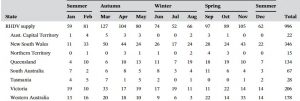Young rabbits are able to survive RHDV infection and develop life-long immunity to the virus. Hence it is strongly recommended that RHDV should not be released when young rabbits are present.
However, it appears that many RHDV releases are occurring when young rabbits would be expected to be present. This means that surviving, immune young would be expected to grow to breeding age and contribute to an increasing, rather than decreasing, rabbit population.
An investigation into the timing of the commercial supply of RHDV and the reported field release of the virus by land managers indicates that, Australia wide, nearly half (47%) of the supply and three quarters (74%) of the releases occurred during the anticipated major breeding seasons and when the risk of immunising young rabbits is greatest. The authors of the study conclude that tighter control may be needed on the supply of RHDV to ensure it remains an ongoing and effective rabbit bio-control.
For a summary of the research, see the Feb 24 article by Pat Taggart in The Conversation.
For more detail and the breakdown of data on a State basis, see the paper by Taggart et. al., ‘Good intentions with adverse outcomes when conservation and pest management guidelines are ignored: A case study in rabbit biocontrol’ in Conservation Science and Practice. 2022; e12639.

RHDV Supply – Total numbers (Taggart et.al. 2022)
